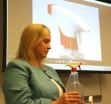(Press-News.org)
VIDEO:
Studies show that when it comes to household cleaners, the spray bottle is the most common source of exposure to injury among children in the US Not only have children...
Click here for more information.
Researchers at The Research Institute at Nationwide Children's Hospital, in partnership with The Ohio State University have developed a prototype for child-resistant spray bottles for household cleaning products. If produced, the prototype would provide an alternative to current, more harmful child-resistant spray bottles while still meeting U.S. Consumer Product Safety commission standards for child resistance.
A Nationwide Children's study* in 2010 revealed that spray bottles were the most common source of exposure to injury in an estimated 267,269 children 5 years of age or younger treated in U.S. emergency departments for household cleaning product-related injuries between 1990 and 2006. These spray bottles are the largest dispensing system type by volume in North America, commonly used for household cleaning and garden products.
The study, led by Lara McKenzie, PhD, principal investigator in the Center for Injury Research and Policy at Nationwide Children's, was the basis for the spray bottle prototype.
"Existing spray bottles for household cleaning-products cannot be designated as truly child-resistant," explained Dr. McKenzie, also a faculty member at The Ohio State University College of Medicine. "While many spray bottles contain a nozzle that controls the stream configuration or closes the spray bottle, these nozzles are not effective if the user does not turn the nozzle back to the 'closed' or 'off' position after each use. These nozzles are also relatively easy for young children to manipulate on their own."
In a pilot study including 25 families of young children, Nationwide Children's investigators found that 75 percent of the nozzles on the cleaning product spray bottles were not in the "closed" or "off" position and therefore posed a potential hazard to young children in the household.
To develop concepts and design a child-resistant spray bottle, Dr. McKenzie's research group partnered with Professors Carolina Gill, MS, BSID, and Scott Shim, MA, BFA, from the Department of Design at The Ohio State University and Professor Blaine Lilly, PhD, from the Department of Mechanical and Aerospace Engineering at The Ohio State University. Together, they developed a distinct method for making spray bottles essentially unusable by children younger than six years of age.
"The two-stage trigger mechanism design restricts the ability of young children to trigger spray bottles because they lack the development capability to perform the correct operational sequence and because their hand size and strength are not sufficient to activate the mechanism," said Dr. Lilly. "The spray mechanism is designed to be extremely challenging for young children to operate, yet will allow adults comfortable use."
Most notably, the prototype features a two-stage trigger mechanism that must be sequentially engaged in order for the spray mechanism to function. The spraying mechanism then automatically returns to a locked state after each use without requiring the user to consciously apply a locking feature, setting it apart from any other existing technology.
"Our long-term goal is to reduce the number of household cleaning product-related injuries in young children through widespread adoption of our product," said Dr. McKenzie. "This technology may set a new 'gold standard' for child safe spray bottles."
Now that the prototype has been finalized, the team plans to identify commercial partners to bring the technology to the public sector. Both the mechanism and design of the spray bottle are patent-pending and available for licensing through the Nationwide Children's Hospital Office of Technology Commercialization at (614) 355-2818 or Tech.Commercialization@NationwideChildrens.org.
INFORMATION:
*McKenzie LB, Ahir N, Stolz U, Nelson NG. Household cleaning product-related injuries treated in US emergency departments in 1990-2006. Pediatrics. 2010 Sep; 126(3):509-16.
For more information on The Research Institute, visit, http://www.nationwidechildrens.org/pediatric-research
For more information on the Center for Injury Research and Policy, visit http://www.nationwidechildrens.org/injury-research-and-policy
For more information on Lara McKenzie, visit http://www.nationwidechildrens.org/lara-b-mckenzie
Nationwide Children's Hospital develops prototype for safer, child-resistant spray bottle
2012-09-12
ELSE PRESS RELEASES FROM THIS DATE:
Forensic science on trial
2012-09-12
The key player in a movement challenging improper use of DNA testing and other elements of forensic science is the topic of a compelling cover story in this week's edition of Chemical & Engineering News. The story in the weekly newsmagazine of the American Chemical Society (ACS) — the world's largest scientific society — features the Innocence Project, which, in the last two decades, has helped free nearly 300 wrongfully convicted prisoners.
C&EN Senior Editor Carmen Drahl uses a symposium on the Innocence Project held at ACS' Fall National Meeting & Exposition to discuss ...
An advance toward a flu-fighting nasal spray
2012-09-12
In an advance toward development of a nasal spray that protects against infection with influenza and spread of the disease, scientists are reporting identification of a substance that activates the first-line defense system against infection inside the nose. They describe effects of a synthetic form of a natural substance found in bacterial cell walls in ACS' journal Molecular Pharmaceutics.
David C. Jackson and colleagues explain that the body's so-called innate immune system forms a first-line defense system against respiratory diseases like influenza A — which causes ...
Record 4.02 billion prescriptions in United States in 2011
2012-09-12
People in the United States took more prescription drugs than ever last year, with the number of prescriptions increasing from 3.99 billion (with a cost of $308.6 billion) in 2010 to 4.02 billion (with a cost of $319.9 billion) in 2011. Those numbers and others appear in an annual profile of top prescription medicines published in the journal ACS Chemical Neuroscience.
Journal Editor-in-Chief Craig W. Lindsley analyzed data on 2011 drugs with a focus on medications for central nervous system (CNS) disorders. So-called antipsychotic medicines — including those used to ...
New analysis of drinking water-related gastrointestinal illness
2012-09-12
The distribution system piping in U.S. public water systems that rely on non-disinfected well water or "ground water" may be a largely unrecognized cause of up to 1.1 million annual cases of acute gastrointestinal illness (AGI), involving nausea, vomiting and diarrhea, scientists are reporting. Their study in ACS' journal Environmental Science & Technology concludes that such illnesses may become more of a problem as much of the nation's drinking water supply system continues to age and deteriorate.
Frank J. Loge, Mark A. Borchardt and colleagues explain that more than ...
Russia fails to grasp democratic ideals
2012-09-12
EAST LANSING, Mich. — The brutally repressive Soviet Union Vladimir Shlapentokh left behind 33 years ago may have opened its borders to the world, but today's Russia has become wracked with greed, corruption and mass emigration that threaten the nation's future.
So argues Shlapentokh, a Michigan State University sociologist, in the academic journal Communist and Post-Communist Studies.
"As Russia's plight shows, the assumption that openness and liberalization automatically promote democracy and guarantee it will function turned out to be wrong," Shlapentokh said. "It ...
Himalayan glaciers retreating at accelerated rate in some regions but not others
2012-09-12
WASHINGTON -- Glaciers in the eastern and central regions of the Himalayas appear to be retreating at accelerating rates, similar to those in other areas of the world, while glaciers in the western Himalayas are more stable and could be growing, says a new report from the National Research Council.
The report examines how changes to glaciers in the Hindu Kush-Himalayan region, which covers eight countries across Asia, could affect the area's river systems, water supplies, and the South Asian population. The mountains in the region form the headwaters of several major ...
Math anxiety causes trouble for students as early as first grade
2012-09-12
Many high-achieving students experience math anxiety at a young age — a problem that can follow them throughout their lives, new research at the University of Chicago shows.
In a study of first- and second-graders, Sian Beilock, professor in psychology, found that students report worry and fear about doing math as early as first grade. Most surprisingly math anxiety harmed the highest-achieving students, who typically have the most working memory, Beilock and her colleagues found.
"You can think of working memory as a kind of 'mental scratchpad' that allows us to 'work' ...
Stress hormones: Good or bad for posttraumatic stress disorder risk?
2012-09-12
Philadelphia, PA, September 12, 2012 – Glucocorticoids, a group of hormones that includes cortisol, are considered stress hormones because their levels increase following stress. When their relationship to stress was first identified, it was shown that the release of cortisol prepared the body to cope with the physical demands of stress. Subsequently, high levels of cortisol were linked to depression and other stress-related disorders, giving rise to the hypothesis that high levels of cortisol on a long-term basis may impair the psychological capacity to cope with stress. ...
New model could help fill data gap in predicting historical air pollution exposure
2012-09-12
MEDFORD/SOMERVILLE, MASS. – In a study that analyzed relationships between air quality and unemployment levels, a Tufts University researcher has developed a new statistical model that retrospectively estimates air pollution exposure for previous time periods where such information is not available.
Mary Davis, an associate professor of urban and environmental policy and planning at Tufts University School of Arts and Sciences, analyzed traffic-related air pollution levels and unemployment rates in four separate regions of California for which extensive air monitoring ...
Amazing diversity documented in national park
2012-09-12
JEJU, REPUBLIC OF KOREA (September 12, 2012) – A remote park in northwest Bolivia may be the most biologically diverse place on earth, according to the Wildlife Conservation Society (WCS), which helped put together a comprehensive list of species found there. The announcement was released at the IUCN World Conservation Congress, an international gathering of conservationists meeting through Sept. 13 in Jeju, South Korea.
The list, published in a compendium by the Bolivian Park Service (SERNAP) and funded by WCS, shows that Madidi National Park contains 11 percent of ...


